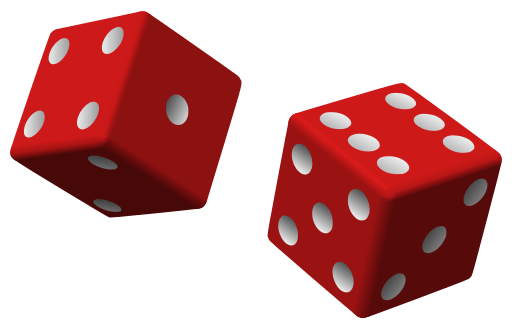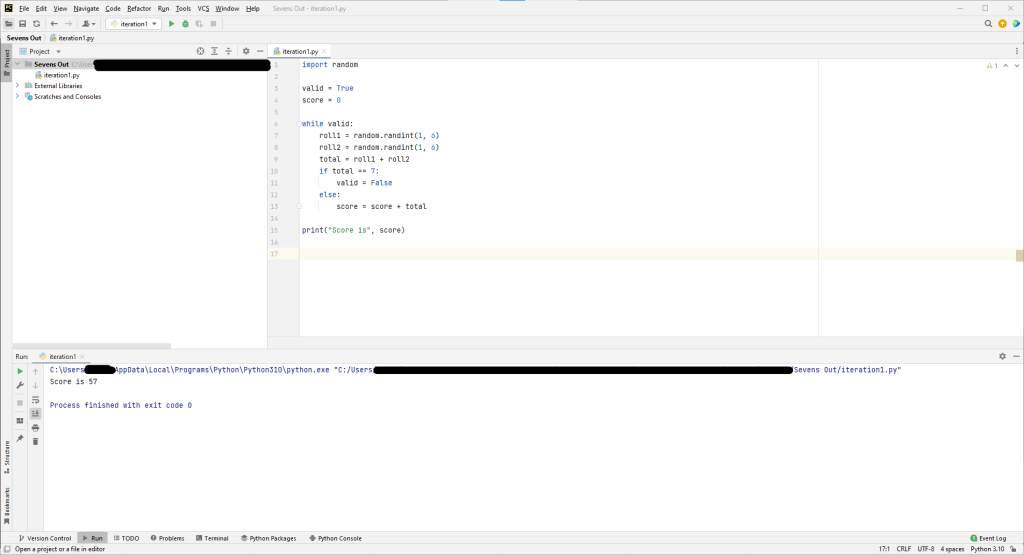Developing a battle system
In this tutorial we will look at the development of a simple battle system. We restrict our attention to a one-on-one battle.
We will implement a Dungeons and Dragons like battle system, where the player and the monster they are facing have a number of hitpoints. The player and monster will take it in turns to attack the other entity. Each attack causes damage that reduces the hitpoints of the entity that was hit. The damage caused by an attack will be randomly determined, but must lie between a predetermined minimum and maximum damage. The battle ends when the hitpoints of either the player or monster are reduced to zero or below.
Initial implementation
The battle mechanics will be encapsulated within the battle function.
The function takes seven inputs. The first three inputs are used for player information, describing the number of hitpoints that they had at the beginning of the combat, the minimum damage that one of their attacks does, and the maximum damage done by their attack. The remaining inputs are used for the title/name of the monster, the monster’s hitpoints and the minimum and maximum damage done by their attack.
The code for the battle mechanics is shown below. The battle function is tested by calling the function at the end of the code listing.
import random
def battle(hitpoints, minDamage, maxDamage,
monsterTitle, monsterHitpoints,
monsterMinDamage, monsterMaxDamage):
playerAttack=True
while (hitpoints>0 and monsterHitpoints>0):
if (playerAttack):
damage=random.randint(minDamage, maxDamage)
monsterHitpoints=monsterHitpoints-damage
print("You did {0:d} hitpoints damage".format(damage))
if (monsterHitpoints <= 0):
print("The {0} is dead".format(monsterTitle))
playerAttack=False
else:
damage=random.randint(monsterMinDamage, monsterMaxDamage)
hitpoints=hitpoints-damage
print("You took {0:d} hitpoints damage".format(damage))
if (hitpoints <= 0):
print("You have been killed".format(monsterTitle))
playerAttack=True
battle(20, 1, 8, "Ogre", 25, 1, 12)
Download source code [Battle mechanics (version 1)].
To randomise the amount of damage done we need to import the random module. From this module we use the randint function, which generates a random integer between the lower and upper bounds which are passed as inputs to the function. To keep track of whether it is the player’s turn or the monster’s turn we use a boolean-valued variable called playerAttack (line 6). This variable can be set to either true or false. A while loop is used to provide a sequence of attacks that continue until either the player or monster is reduced to zero or less hitpoints (line 7). Lines 8-14 of the code implement the player’s attack. The randint function is used to determine the amount of damage done, this is then subtracted from the monster’s hitpoints. If the monster’s hitpoints are reduced below zero, then the monster is declared dead. Lines 15-21 use a similar sequence of code to implement the monster’s attack. The boolean-valued playerAttack variable is updated after each attack to ensure that the player and monster have alternate attacks.
Determining if attacks hit
In the first version of the battle mechanics code all attacks hit. However it is more realistic that only some attacks hit – the attacker may have just swung wildly and missed their target, or the defender may have managed to dodge the attack, or perhaps even parry the attack with their shield. The improve the battle mechanics we adapt the code so that only some of the attacks hit their target. In the code shown below we assume that the player has a 50% chance of hitting their opponent, while the monster only has a 25% chance of hitting.
def battle(hitpoints, minDamage, maxDamage,
monsterTitle, monsterHitpoints,
monsterMinDamage, monsterMaxDamage):
playerAttack=True
while (hitpoints>0 and monsterHitpoints>0):
if (playerAttack):
hitRoll=random.randint(1,20)
if (hitRoll>=11):
damage=random.randint(minDamage, maxDamage)
monsterHitpoints=monsterHitpoints-damage
print("You hit!")
print("You did {0:d} hitpoints damage".format(damage))
if (monsterHitpoints <= 0):
print("The {0} is dead".format(monsterTitle))
else:
print("You missed")
playerAttack=False
else:
hitRoll=random.randint(1,20)
if (hitRoll>=16):
damage=random.randint(monsterMinDamage, monsterMaxDamage)
hitpoints=hitpoints-damage
print("{0} hit".format(monsterTitle))
print("You took {0:d} hitpoints damage".format(damage))
if (hitpoints <= 0):
print("You have been killed".format(monsterTitle))
else:
print("{0} missed".format(monsterTitle))
playerAttack=True
Download source code [Battle mechanics (version 2)].
Lines 7 and 8 of the above code are used to determine whether or not the player hits the monster. A random integer between 1 and 20 is generated and if this number if 11 or larger the player hits the monster, otherwise the attack results in a miss. Similar code is given on lines 19-20 to determine whether or not the monster hits.
Improvements
We improve the code by firstly generalising the hit chances of the player and monster by adding these as variables. We also add a return statement at the end of the code showing how many hitpoints the player has at the end of the battle. This will be used when we call the function in the game to keep track of the ongoing health of the player as well as to determine whether or not the game continues.
def battle(hitpoints, minDamage, maxDamage, toHit,
monsterTitle, monsterHitpoints,
monsterMinDamage, monsterMaxDamage, monsterToHit):
playerAttack=True
while (hitpoints>0 and monsterHitpoints>0):
if (playerAttack):
hitRoll=random.randint(1,20)
if (hitRoll>=toHit):
damage=random.randint(minDamage, maxDamage)
monsterHitpoints=monsterHitpoints-damage
print("You hit!")
print("You did {0:d} hitpoints damage".format(damage))
if (monsterHitpoints <= 0):
print("The {0} is dead".format(monsterTitle))
else:
print("You missed")
playerAttack=False
else:
hitRoll=random.randint(1,20)
if (hitRoll>=monsterToHit):
damage=random.randint(monsterMinDamage, monsterMaxDamage)
hitpoints=hitpoints-damage
print("{0} hit".format(monsterTitle))
print("You took {0:d} hitpoints damage".format(damage))
if (hitpoints <= 0):
print("You have been killed".format(monsterTitle))
else:
print("{0} missed".format(monsterTitle))
playerAttack=True
return hitpoints
Testing the balance of the battle mechanics
Before we add the battle mechanics to the game we need to test it to make sure it has the right balance. We don’t want to always die when they battle a monster, but at the same time the monster should not be a pushover. Furthermore, if the player acquires an item that is supposed to give them an edge in combat then it should indeed give them and edge. To test the battle function we need to call it many times and then analyse the number of player wins versus the number of player losses. The best way to do this to use a for loop as shown in the code below.
wins=0
for i in range(0,1000):
hps=battle(20, 1, 8, 11, "Ogre", 25, 1, 12, 16)
if (hps>0):
wins=wins+1
print(wins)
In this case the player has 20 hitpoints and a to-hit-roll of 11 (meaning they will need at least an 11 on a roll between 1 and 20 to hit). The monster has 25 hitpoints, does more damage, but is only half as likely to hit. Running the battle mechanics 1000 times with the given configuration results in the player winning 60.5% of the battles. This is probably too high in the situation when the player has not found the sword, but too low if they have found the sword. This suggests we need to adjust the player statistics for these two scenarios. We will use trial an error to get a 20% win chance if they don’t have the sword and an 80% win chance if they do have the sword.
Modifying the player’s damage to 1-4 hps and increase the to-hit-roll to 12 gives the player a win percentage of approximately 20%. On the other hand, if we change the player’s damage to 4-10 and decrease the to-hit-roll to 11, the player will have a win percentage of 79%.
Integrating battle mechanics into the game
To integrate the battle mechanics into the game we modify the playLocation3 function. When the player selects the attack option, the code will call the battle function. The values passed to the battle function depend on whether or not the player has picked up the sword earlier in the game, remembering that possessing the sword gives the player a much better chance of defeating the Ogre (compare lines 20 and 23).
def playLocation3():
global inventory
print("You reach what looks like a rudimentary camp site.")
print("You notice a fire pit in the middle of the camp site.")
print("Scattered around the fire pit are the many bones picked clean of flesh.")
print("Ominously some of the bones look human like.")
print("Just as you finish surveying the scene you here a roar.")
print("Running towards you, wielding a large club is an Ogre.")
print("You can either (f)lee to the south, (a)ttack the Ogre or try to (t)alk with the Ogre.")
response=input("> ")
if (response=="f"):
print("You run away from the Ogre at full speed")
print("The Ogre pursues for a while but eventually gives up.")
print("You survive another day.")
print("Once you know you are safe you continue your journey southward at a slower pace.")
location="location1"
elif (response=="a"):
if ("sword" in inventory):
print("As the Ogre draws near you draw your sword.")
hps=battle(20, 4, 10, 11, "Ogre", 25, 1, 12, 16)
else:
print("You pick up a fallen branch from the ground and prepare to battle the Ogre")
hps=battle(20, 1, 4, 12, "Ogre", 25, 1, 12, 16)
if (hps >0):
print("You have felled the evil beast.")
print("You search the body of the Ogre and find a key.")
print("You take the key and head back towards the clearing with the chest.")
location="location1"
inventory.append("key")
else:
print("You fight valiantly with the Ogre.")
print("You manage to inflict several telling blows against it but it fights on.")
print("Having dodged several sweeping blows, the Ogre brings its club down upon you with a crash.")
print("...")
location="finish"
elif (response=="t"):
print("You attempt to make conversation with the Ogre but this only makes it more angry.")
location="location3"
else:
location="location3"
return location
Download source code [Stage 4 code]


